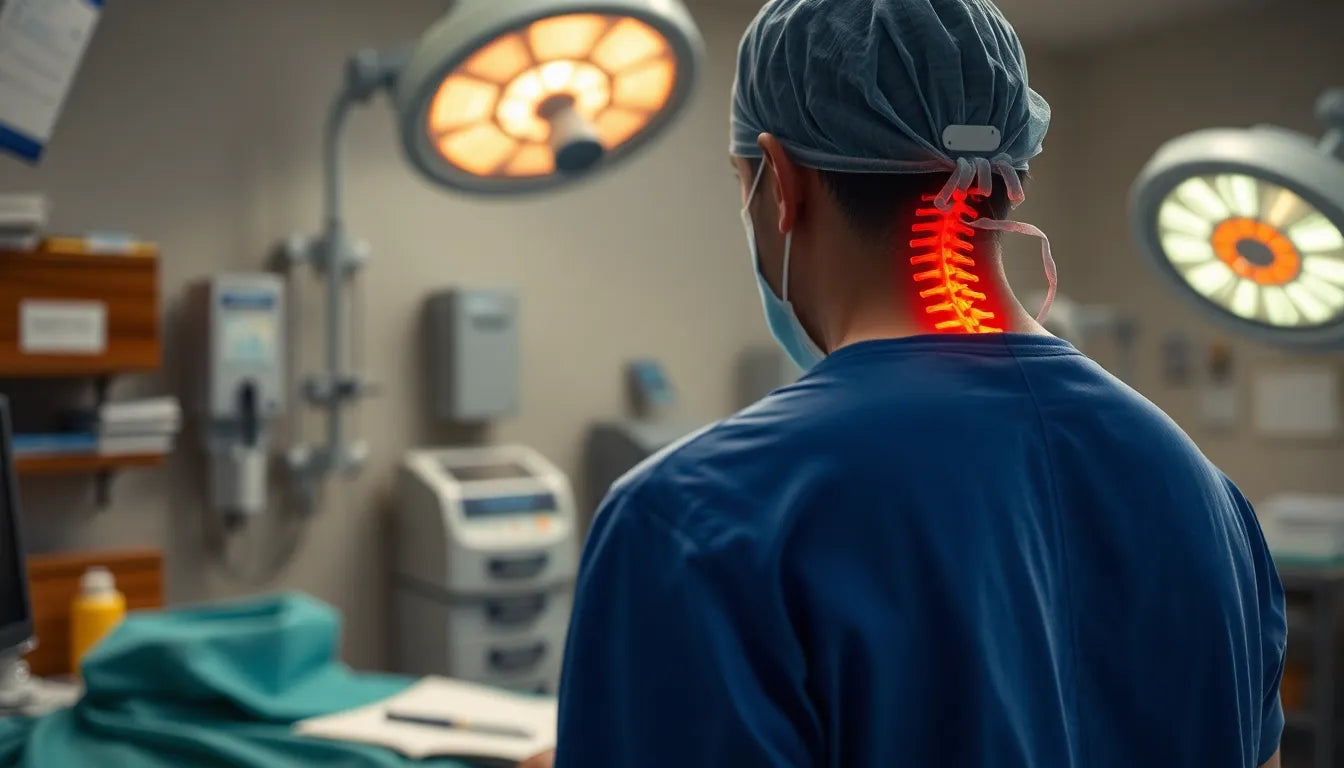Dealing with a herniated disc can be a daunting experience, particularly when it leads to a blockage. A herniated disc occurs when the soft, gel-like center of a spinal disc pushes through a crack in the tougher exterior casing. This condition can lead to a blockage, where the protruding disc material compresses or "blocks" nerve roots, causing significant pain and discomfort. Understanding this process is crucial in identifying the right path to relief and recovery.
Herniated discs are more common than many might think, affecting a significant portion of the population, particularly those over the age of 30. The resulting nerve pain from a herniated disc blockage can range from mild tingling to severe, debilitating pain, impacting everyday activities and overall quality of life. This prevalence underscores the importance of exploring effective relief options, as many individuals seek ways to manage and alleviate their symptoms.
the journey to pain-free living
Embarking on the journey to pain-free living starts with an accurate diagnosis and a tailored treatment plan. The complexity of herniated disc blockages means that a one-size-fits-all approach is rarely effective. Instead, personalized care that considers the specific nature of the blockage and its impact on the individual's health is essential. This blog will delve into various treatment options, both conservative and interventional, highlighting the role of nerve blocks as a pivotal intervention.
Nerve blocks have emerged as a key component in managing pain associated with herniated disc blockages. These injections, often containing steroids or anesthetics, are designed to reduce inflammation and alleviate nerve pain. By effectively targeting the source of discomfort, nerve blocks can provide significant relief for many patients, making them a critical option in the treatment landscape.
In the following sections, we will explore conservative treatments as the first line of defense, detailing how rest, medication, and physical therapy can play a role in managing symptoms. We will also take a closer look at nerve blocks, offering insights into the procedure, expected outcomes, and when they might be necessary. Ultimately, this blog aims to equip you with the knowledge needed to navigate the complexities of herniated disc blockages and find a path to a pain-free life.
conservative treatments: the first line of defense
When addressing a herniated disc blockage, conservative treatments often serve as the initial approach. Rest and medication are critical components of this strategy. Short periods of rest can help reduce inflammation and alleviate pain, while over-the-counter pain relievers such as ibuprofen or acetaminophen provide additional relief. These medications work by targeting inflammation, a primary cause of nerve irritation and discomfort.
Physical therapy is another cornerstone of conservative treatment. A well-designed physical therapy program aims to strengthen the muscles supporting the spine, improve flexibility, and reduce pressure on the affected nerve roots. Through targeted exercises, patients can increase their range of motion and enhance their overall spinal health, which is crucial for long-term recovery.
| Conservative Treatment Options | Benefits |
|---|---|
| Rest | Reduces inflammation and pain |
| Medication | Provides pain relief and reduces inflammation |
| Physical Therapy | Strengthens muscles, improves flexibility, and reduces nerve pressure |
nerve blocks: a closer look
Nerve blocks are a significant intervention for those who do not find relief from conservative treatments. These injections are designed to target the source of nerve pain directly. By delivering steroids or anesthetics near the affected nerve, nerve blocks can effectively reduce inflammation and interrupt pain signals, providing substantial relief for many patients.
The procedure for receiving a nerve block is typically straightforward. It involves the injection of a combination of anesthetics and steroids directly into the area around the nerve. This is usually performed under imaging guidance to ensure precision. The anesthetic provides immediate pain relief, while the steroid works over time to reduce inflammation and swelling.
The expected outcomes of nerve blocks can vary. Many patients experience significant pain relief, which can last from several days to several months, depending on the individual case. However, as with any medical procedure, there are potential risks, including infection, bleeding, or an adverse reaction to the medication. It is essential to discuss these possibilities with a healthcare provider to make an informed decision.
when conservative measures aren’t enough
In cases where conservative measures fail to provide adequate relief, a graduated treatment pathway is often recommended. This approach begins with conservative care, such as rest and physical therapy, and progresses to interventional pain management techniques like nerve blocks or epidural steroid injections. If these interventions do not yield the desired results, minimally invasive or surgical procedures may be considered.
Accurate diagnosis is crucial in determining the appropriate treatment step. Imaging techniques such as MRI or CT scans, along with diagnostic blocks, help pinpoint the exact source of pain, allowing for a more tailored treatment approach. This ensures that patients receive the most effective care for their specific condition, improving the likelihood of successful outcomes.
Ultimately, navigating the complexities of herniated disc blockages requires a comprehensive understanding of available treatment options. By exploring both conservative and interventional strategies, patients can find a pathway to relief that best suits their needs, paving the way for a pain-free life.
Minimally invasive and surgical options
When conservative and interventional treatments do not provide sufficient relief from herniated disc blockage, minimally invasive and surgical options may become necessary. These procedures are typically considered when there is significant nerve compression, persistent pain, or neurological deficits that impact daily functioning. Total Spine Ortho and ProMedSpine emphasize the importance of accurate diagnosis and careful consideration before proceeding with surgery.
Minimally invasive surgeries, such as microdiscectomy or endoscopic discectomy, aim to remove the herniated portion of the disc with minimal disruption to surrounding tissues. These procedures often result in shorter recovery times and less postoperative pain compared to traditional open surgeries. In more severe cases, spinal fusion or artificial disc replacement might be recommended to stabilize the spine and alleviate symptoms.
While surgical interventions can offer significant relief, it's crucial to weigh the potential benefits against the risks. Consulting with a spine specialist can help determine the most appropriate course of action based on individual circumstances.
Ergonomic aids and long-term prevention
Preventing further injury and managing pain from herniated disc blockage involves more than just medical interventions. Ergonomic aids play a vital role in supporting posture and reducing strain on the spine. These aids can include specialized chairs, lumbar supports, and adjustable workstations designed to maintain spinal alignment and minimize pressure on affected areas.
Anodyne offers a range of ergonomic solutions that can integrate seamlessly into a comprehensive pain management plan. By incorporating these aids into daily routines, individuals can enhance their quality of life and reduce the risk of future disc issues. Long-term prevention strategies also involve maintaining a healthy weight, engaging in regular physical activity, and practicing proper body mechanics during daily tasks.
Frequently Asked Questions
What is a nerve block for disc pain?
A nerve block is an injection that contains steroids or anesthetics, aimed at reducing inflammation and pain caused by a herniated disc. It targets the nerves affected by the disc's compression, providing relief from discomfort.
Do herniated discs cause nerve blockage?
Yes, herniated discs can compress nerve roots, leading to pain and what is often referred to as "blockage." This compression can affect nerve function and result in symptoms such as pain, numbness, or weakness.
When is surgery for a herniated disc necessary?
Surgery is considered when conservative and interventional treatments fail to relieve symptoms, or if there is significant nerve damage or loss of function. It is crucial to evaluate the potential benefits and risks with a healthcare provider.
Can ergonomic aids help with herniated disc pain?
Ergonomic aids can support posture, reduce strain, and complement other treatments to manage pain effectively. By maintaining proper spinal alignment, these aids can help prevent further injury and improve overall comfort.
Sources
- Medical News Today. "Herniated Disc: Symptoms, Causes, and Treatment."
- UR Medicine. "Herniated Disk: Overview." University of Rochester Medical Center.
- Total Spine Ortho. "Herniated Disc: Treatment Options and Procedures."
- ProMedSpine. "Understanding Herniated Discs and Treatment Options."
- Penn Medicine. "Herniated Disc: Condition Overview."
- Cleveland Clinic. "Herniated Disc: Symptoms, Causes, and Treatments."


















